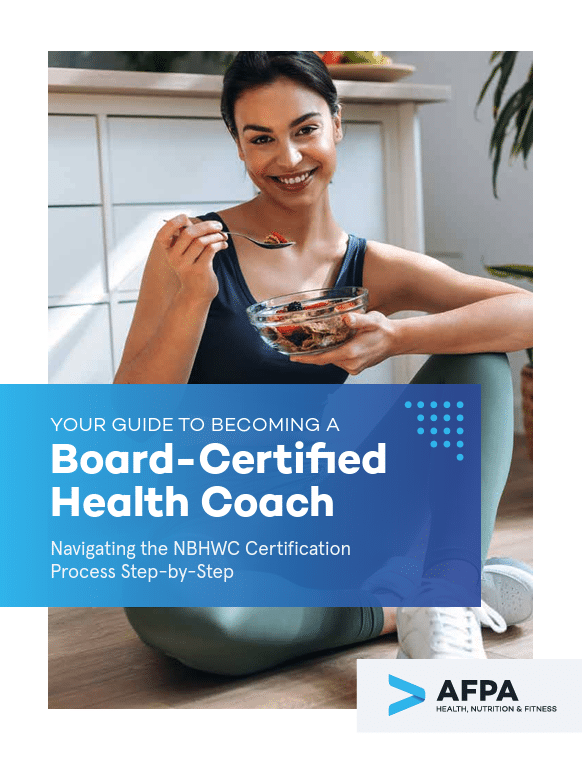Every client is different. They come to you from diverse backgrounds, harboring varying fitness goals, knowledge, skills, and even levels of motivation in following the fitness plans you’ve designed for them.
As a certified personal trainer, though, your responsibility remains the same for each client: to craft a tailored fitness plan best suited to help them reach—and, better still, exceed—their goals. Although the problem is, with so many considerations to account for, where do you even begin?
This article outlines the top five areas to explore that’ll have you crafting the best fitness plan designed to deliver results—with any client.

Grow Your Income and Impact as a Personal Trainer and Board-Certified Health Coach
What Are Your Client’s Goals?
What does your client need your help with?
This is one of the most critical areas you’ll have to explore when designing the best fitness plan for your client. A workout program meant to help a client lose weight will look very different from the one intended to help a client prepare for an upcoming physique show.
With the former, you’ll enjoy greater flexibility with workout programming. This means you have more room to play with in terms of exercise selection and preferences, which can help your clients (beginner or not) better stick to their fitness plan.
But this principle doesn’t apply to another looking to transform their physique completely.
This client’s fitness plan would likely have to be centered around distinct phases of muscle-building and fat loss. You will need to focus on exercise selection, total training volume, progressive overload, lifting tempo, amongst other factors.
Fail to understand why your client’s engaged your help in the first place—and you’ll fail to craft a fitness plan that’ll help them reach their goals.
Fortunately, though, the flipside holds: Understand your client’s dreams and aspirations, and you’re one step closer to building a long-term, mutually beneficial relationship with them.
What Has Your Client Tried Before Engaging You?
Exploring this area helps you gain valuable insight into all the other things they’ve tried (e.g., online fitness programs, other personal trainers, or simply winging it on their own) that have failed to help them achieve their fitness goals.
Be sure to listen and dig deeper into your client’s beliefs on why their previous approaches failed.
For example: Were they doing exercises they didn’t enjoy? And if so, what were these exercises, exactly? Getting hold of all these details allows you to craft a fitness plan that they’ll better enjoy, which boosts long-term adherence and client satisfaction.
And perhaps more than that, this knowledge will also inform you of the amount of client education required.
That’s because chances are, your client will have also unwittingly revealed some of their fitness misconceptions during the process. Some clients may mistakenly believe that copious amounts of cardio are needed for weight loss.
These beliefs may be deep-seated; correcting them right from the get-go—and programming a ton of strength training exercises within their fitness plan—runs a very high risk of alienating your client.
A better way to go about this is to start them off with exercises they’re familiar with first.
Once your bond is stronger (i.e., your client trusts you more), and you’ve proven that you can get results, you’ll be better able to introduce resistance training to their fitness plan, which would fast-track their progress.
Takeaway? Build trust first. Then, educate.
How Will Training Fit into Your Client’s Life?
There’s no point planning “The Best Fitness Plan” for your client that they wouldn’t be able to adhere to because of their schedule—nor one that fails to account for where personal training fits on their priority list.
Say you have a busy client that only has thirty minutes with you per week.
Structuring their fitness plans according to a traditional resistance training program, where rest periods between sets can range anywhere between two to three minutes, isn’t going to be a wise choice. Instead, you (and your client) will most likely see the most results from a circuit-based (e.g., HIIT) program.
Another lifestyle detail you’ll need to know about your client is their occupation.
A client who works a sedentary desk job for ten hours a day, for instance, is likely to have tight hip flexors.This impacts their daily posture and their ability to activate the glute muscles, which is integral to many basic lifting movement patterns, including deadlifts and squats. So, with clients like this, including mobility work (e.g., kneeling hip flexor stretch, pigeon stretch) and glute-strengthening exercises (e.g., glute bridges) will be paramount to your fitness plan’s effectiveness.
What’re Your Client’s Current Capabilities?
By now, you should have a firm grasp of what your client wishes to achieve with your help.
But what will it take for your client to get there? Do they have their fundamentals down-pat? Or, will you need to dedicate a significant portion of time just building up their necessary cardiovascular fitness, strength, and mobility?
You’ll have to know the answer to these questions if you’re looking to design the best possible fitness plan for a particular client.
Only once you’ve understood your client’s current level of fitness, skill, or whatever you may be training can you set a realistic fitness plan that’ll truly help them reach their goals.
Struggling with this? No worries. You can put them through a comprehensive assessment or mini-workout, where you:
- Measure cardiovascular fitness: There’s more than one way to do this, but the One-Mile Walk Test and the Step Test are both effective ways to identify your client’s starting point for cardio-related programming.
- Evaluate mobility: Guide your client through a series of basic movements, including lunges, squats, and overhead arm extensions, to evaluate their range of motion. Take note of any issues you notice; this information will help you identify critical things you need to include when designing your client’s fitness plan.
- Assess strength: There are multiple ways to assess strength, but one of the most popular methods you can employ is through a five-rep max for various exercises (e.g., barbell squats, bench press, leg press). This is also the perfect opportunity to see if your client already has a firm grasp on each exercise’s execution—or not.
Is Your Client Struggling with a Chronic Injury?
Some clients will come to you with pre-existing injuries.
Common issues like shoulder impingement, knee pain, lower back pain, and muscle imbalances can prevent your client from making the most out of their workout programs.
You must take their injuries into account when crafting their fitness plan—and modify exercises as needed. Here are a few examples of the modifications you’ll need to make if your client is struggling with the following:
- Knee pain: Substitute high-impact, explosive movements with low-impact, closed-chain leg exercises like quad dips, wall sits, and lateral step-ups.
- Herniated disc: Avoid exercises that involve a large amount of compression at the spine, including barbell back squats, barbell rows, and overhead presses. Instead, include lower-back-friendly exercises like goblet squats, barbell split squats, and suspension inverted rows.
- Shoulder impingement: For a client struggling with shoulder issues, you’ll generally want to focus on strengthening problematic areas like the lower traps, serratus anterior, and external rotators. Make sure you include exercises that target these within your client’s fitness plan.
Main Takeaways
Ultimately, designing the “best” fitness plan for any client is more of an art than a science—there is no set recipe for success.
But one thing’s for sure. It all starts with uncovering what your client wants and needs. And this is only possible when you start listening and putting yourself in their shoes. Only then can you develop an approach that’s sustainable and rewarding for both you and the client.
How are you doing on your coaching journey? Tag @AFPA_Fitness in your Instagram posts—and be sure to reach out if you need any tips along the way!




